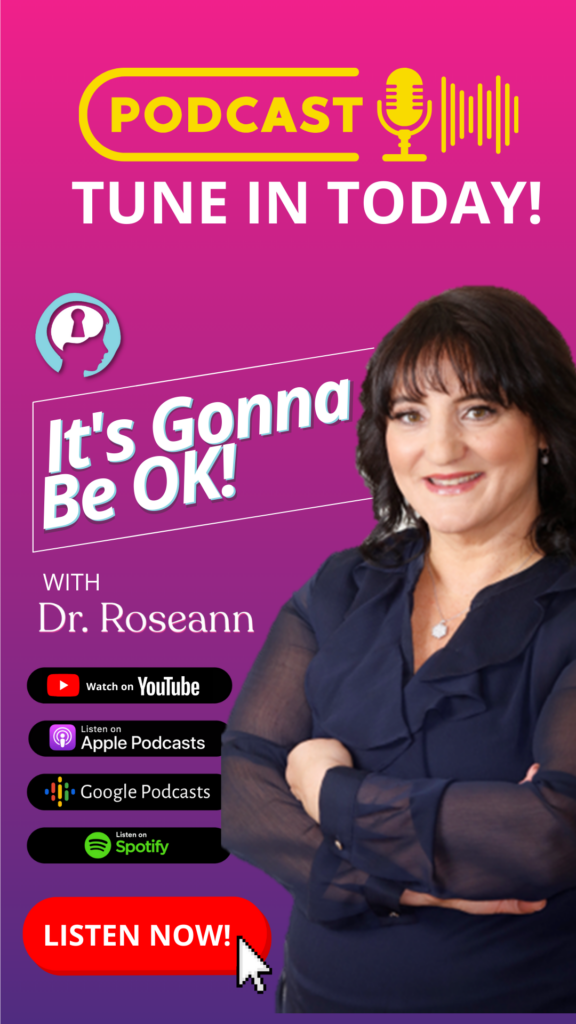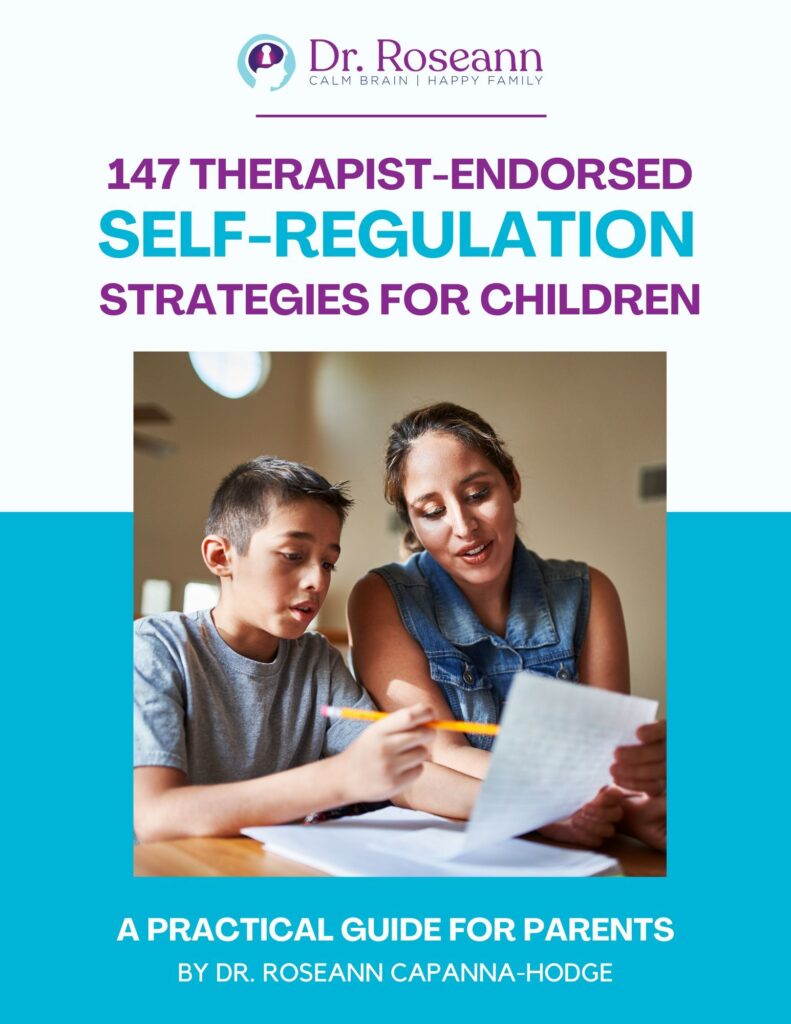Obsessive Compulsive Disorder (OCD) is a disorder that often starts in childhood and wreaks havoc on a person’s and their families’ life. At Dr. Roseann, LLC we support children, teens, and adults with OCD disorder every day with brain-based therapies, such as neurofeedback and biofeedback combined with Cognitive Behavioral Therapy (CBT) and Exposure Therapy.
Children and adults with OCD experience unreasonable thoughts and fears (obsessions) leading to compulsive behaviors and rituals (physical and mental). Individuals with OCD engage in compulsive behaviors attempting to end the obsessions, decrease distress and anxiety, or stop perceived bad things from happening. As part of OCD, individuals perform both mental and behavioral rituals to reduce feelings associated with anxiety. These signs of OCD take up a considerable amount of their time every day (one hour or more) and interfere with their daily functioning (home, school, work, relationships, etc.).
How do You Stop OCD?
Through the use of different therapies, one can learn to manage and sometimes eliminate obsessions and compulsions. It is a process that typically involves working with a psychotherapist. Symptoms can increase during periods of stress, as well as hormone and developmental change. Getting support when symptoms first appear is key to successfully manage obsessions and compulsions before one becomes habituated to the behaviors. One can learn healthy ways to manage anxiety and obsessions and compulsions.
What is OCD Treatment?
OCD is treated using a variety of traditional and holistic therapies. Some people benefit from medication, and others don’t. The research supports OCD medication as negatively reinforcing the behaviors thus making people treatment resistant. A consistently proven effective treatment for OCD is Cognitive Behavioral Therapy (CBT) and Exposure Therapy (and more specifically Response and Prevention Therapy).
Holistic therapies, such as Neurofeedback, Biofeedback, EFT/Tapping, and massage can also be good adjunctive therapies to help align the nervous system. Before a person can fully move forward in clinical therapy, they need to calm the brain first.
What is Exposure Therapy?
Exposure therapy is a type of treatment that was developed to help people confront their fears. Exposure therapy has been scientifically demonstrated to be a helpful treatment for a variety of issues, including Phobias, Panic Disorder, Social Anxiety Disorder, Obsessive-Compulsive Disorder, Post-Traumatic Stress Disorder, and Generalized Anxiety Disorder.
Exposure Therapy and CBT
Cognitive Behavioral Therapy (CBT) is a type of psychotherapy that works at the conscious level. CBT is combined with Exposure Therapy to help people challenge irrational fears and worries. CBT presumes that how individuals perceive a situation is more connected to their reaction than to the situation itself thus working through those misperceptions brings relief. CBT combines talk and behavioral therapy to reframe negative thinking patterns into positive thoughts. So, in other words, you learn to break that negative internal looping. Research has found CBT to be more effective than medication in reducing symptoms (59.9 % vs. 33.4%) and widely considered to be the first line of treatment in OCD.
How to Treat OCD with Exposure Therapy
Exposure therapy is a type of behavioral therapy where a person is gradually and systematically exposed to their fears. Therapists create a safe environment where an individual can learn to tolerate their fears to reduce avoidance of dreaded situations and reduce anxiety and panic. There are several ways a therapist can expose a client to their fears; types of exposures include:
- Imaginal Exposure: In this type of exposure, a person in therapy is asked to mentally imagine and confront the fear or situation. For example, a person with a fear of germs may be asked to imagine a sick person next to them.
- In Vivo Exposure: When using this type of exposure, a person is exposed to real-life objects and situations. For example, a person with a fear of germs is asked to pick up a dirty ball.
- Virtual Exposure: Through the use of technology, this type of fabricated exposure combines elements of both imaginal and in vivo exposure so that a person is placed in situations that appear real but aren’t. For example, someone who has a fear of germs might participate in a virtual simulation of touching an object that someone just coughed on.
What Techniques are Used in Exposure Therapy?
Exposure therapy incorporates a variety of techniques to help a person confront their fears. As part of the intake and therapeutic process, a therapist determines what are the best techniques to use to assist with the exposure process. Techniques include Systematic Desensitization, graded exposures, flooding, prolonged exposures, and Response and Prevention Therapy (E/RP).
- Systematic Desensitization is a technique incorporates relaxation training, the development of an anxiety hierarchy (rating of items that produce anxiety from least to worst), and gradual exposure to the feared item or situation.
- Graded Exposures is a technique is similar to Systematic Desensitization, but does not integrate the use of relaxation techniques and instead the emphasis is on the anxiety hierarchy and working through that hierarchy with gradual exposures.
- Flooding is a technique where a person is intensely exposed (in vivo or imaginal) to anxiety-producing events for a prolonged period typically until the anxiety is significantly diminished.
- Prolonged Exposure is a technique that is similar to flooding but has a stronger emphasis on psychoeducation and cognitive processing (learning how to block and reverse cognitions). With prolonged exposure, you learn to address trauma-related memories, feelings, and situations that you have been avoiding. PE is often used with those with PTSD.
- Response and Prevention Therapy (see below)
What is Exposure and Response Prevention Therapy (ERP or E/RP)?
Exposure and Response Prevention Therapy (E/RP or ERP Therapy) is a combination of Exposure Therapy and Cognitive-Behavior Therapy (CBT) that exposes the person to their trigger so they learn how to be uncomfortable to the point where they can ignore their trigger. Before E/RP begins deep psychoeducation about the OCD impacts brain and behavior is essential for both the child or teen and parent. Understanding the neuropsychological mechanisms of anxiety and OCD helps one to move forward in therapy.
With E/RP, first, the person identifies all the triggers. Next, the therapist exposes the person to the situations that trigger his or her obsessions and compulsions (sometimes starting gradually and other times addressing more moderate triggers). The therapy emphasizes learning how to deal with the uncomfortableness rather than avoiding it, as the latter leads to negative reinforcement. Patients learn that with exposure, their anxiety increases, but it also decreases. They safely test the limits of their fears with a therapist guiding them through the awareness that their fears aren’t rational and their exposure experiences are a validation of that.
Over time, through psychoeducation and cognitive behavioral therapy, the person’s response to triggers changes, leading to a decrease in the frequency of compulsions and the intensity of obsessions. OCD treatment and anxiety expert, Kimberly Morrow, LCSW explains “We have to teach clients that they are “feeding the dog” with negative thinking and they have to understand that OCD is a bully that they can overcome”. Therapeutic exposures repeated over time decrease associated anxiety because the individual learns that nothing bad happens when they stop performing rituals. They can learn to stop OCD from bullying them. Cognitive restructuring is part of the process, so they learn to evaluate perceived threats associated with each obsession and then test limits. And when their anxiety does get too high in a session, a therapist is trained to support the client through the exposure.
There is work to be done outside of the session too, as practicing managing exposures transfers from the therapy session to the real world. Review of that practice is part of each session. With children, parents are part of every session, and they learn to support exposures at home, as well as get their child or teen to learn how to tolerate the discomfort.
Upon completion of E/RP therapy, OCD intrusive thoughts and symptoms often diminish or disappear. Ultimately, the person with OCD learns to tolerate the discomfort and not be so triggered. Moreover, as part of the E/RP process, they also learn strategies to cope with the anxiety that breaks the anxiety cycle.
Exposure Therapy for Anxiety
Research has shown that exposure therapy for anxiety has been shown to be an effective short-term and long-term treatment. The primary way exposure therapy works is to break the worry cycle that often hijacks one’s brain. When one is anxious, they often spend a considerable amount of time caught up in their worries and fears. Exposure therapy can be an effective treatment for a variety of anxiety-related conditions, such as generalized anxiety, phobias, social anxiety, and so on.
Exposure Therapy for Phobias
It isn’t unusual for someone to have a fear of flying and be so fearful that one never flies. That isn’t going to interfere with your functioning unless your job requires you to travel.
Exposure therapy is used for more than OCD and is also often used for the treatment of specific phobias. With phobias, a person avoids specific phobias inducing stimuli or situation. They negatively reinforce their phobia by continually avoiding it. Exposure therapy is about breaking that behavioral cycle.
Depending on the type of phobia, exposure may be a real (in vivo) or simulated (imaginal), including virtual reality exposures. Typically the exposures are gradual but may involve flooding at some point. While phobias are common, it becomes a clinical issue when it interferes with your daily functioning.
How Effective is ERP Therapy for OCD?
With approximately 42% of those with OCD found to be treatment resistant (Krebs et. al, 2015), we need to look to the science to tell us what works in treating the neuro-behavioral components of OCD.
ERP is the gold standard in treating OCD not just for immediate symptom reduction but for long-term symptom reduction, especially in comparison to all to commonly used psychiatric medications. Studies show that 45% to 89% of patients treated with SRIs have a reoccurrence of OCD symptoms after medication discontinuation, improvement after ERP tends to persist long-term (Krebs et. al, 2015).
And when it comes to psychotherapy, the quality of the therapy and the therapist matters. When a therapist just does CBT alone without exposures, the quality of previous CBT was assessed in research participants as inadequate in 95.5% of cases, with the most common inadequacy was insufficient focus on exposure techniques (Law & Boisseau, 2019).”
How Can I Help My Child or Teen With OCD?
The best thing you can do is to get your child or teen help from a licensed and highly trained mental health professional. Obsessions and compulsions often appear between at a young age and shouldn’t be ignored. The longer they occur, the more behaviorally ingrained they become and therefore harder to break the “habit.” Children and teens can become habituated toward obsessive and compulsive behaviors as a way to cope with stress. Breaking those behaviors before they become ingrained can lessen the severity and, in some cases, stop the progression of OCD.
Even when obsessions and compulsions have already become more ingrained and are debilitating, forms of treatments, including Exposure Therapy- Response and Prevention (E/RP) and neurofeedback can help.
Parent psychoeducation and participation in the E/RP therapy sessions and the process is critical for supporting a child or teen with OCD or another anxiety-related condition. Both the child and parent need psychoeducation about how OCD, anxiety, phobias, social anxiety, and so on the impact the brain and body. Parents need to help with the exposure process by not allowing a child to suppress the obsessions and compulsions and instead learn to tolerate them. This process helps to lessen, if not extinguish, obsessions and compulsions and restore functionality and wellness.
We offer ERP therapy for OCD at our Ridgefield, CT center. We offer both traditional ERP therapy and ERP intensives and are members of The International OCD Foundation (IOCDF). Working with a highly trained ERP therapist is critical for addressing those behaviors that make OCD so treatment resistant. We pair neurofeedback with ERP to calm the CNS and teach new skills, or rather, replace habits (negatively reinforced behaviors), so one can “talk back to their OCD.” To learn more about how neurofeedback helps to reduce anxiety and OCD symptoms, read neurofeedback for OCD.
Want to learn more about OCD?
Wondering what are the signs and symptoms of OCD? Then read this article, What is OCD? OCD in children can look different than adults and is often missed. It often starts with subtle behaviors, such as a need for reassuring questions, insistence on nighttime rituals, or other behaviors that you may interpret as, “nerves” or worry. To learn more about the signs and symptoms of OCD in children and teens, read this blog to help you understand what's the difference between anxiety and OCD. There are great natural treatments for OCD, including supplements for OCD or herbs for OCD, neurofeedback for OCD, and Exposure and Response Prevention for OCD. Looking for information on natural solutions and treatments for OCD? Then download this FREE Natural Solutions and Treatments for OCD. And wondering what the research says what dosages of these herbs and supplements your child should be taking, then download this FREE OCD Supplement Checklist.
Are you looking for help for your child’s or teen’s behavior?
Boy, the world is stressful right now (and it has been for a long time!). Of course, you are worried about your child’s mental health! Your child may be struggling with focus, stress, mood, behavior, emotions, or socially and you aren’t sure what to do about it and you feel STUCK… Well, Dr. Roseann is here to show you how to GET UNSTUCK!
As a licensed therapist and certified psychologist, as well as a special needs mom herself, Dr. Roseann knows what it is like to search for ways to help your child’s attention, learning, and behavior and still see your child struggle. So, if you’ve gone down the Google MD and ineffective medication and therapy rabbit hole, it is time to get support from Dr. Ro who can help you help your child to be focused, calm, and feel good about themselves.
Citations:
Krebs, G., Isomura, K., Lang, K., Jassi, A., Heyman, I., Diamond, H., Advani, J., Turner, C., & Mataix-Cols, D. (2015). How resistant is ‘treatment-resistant' obsessive-compulsive disorder in youth?. The British journal of clinical psychology, 54(1), 63–75. https://doi.org/10.1111/bjc.12061
Law, C., & Boisseau, C. L. (2019). Exposure and Response Prevention in the Treatment of Obsessive-Compulsive Disorder: Current Perspectives. Psychology research and behavior management, 12, 1167–1174. https://doi.org/10.2147/PRBM.S211117
Always remember… “Calm Brain, Happy Family™”
Disclaimer: This article is not intended to give health advice and it is recommended to consult with a physician before beginning any new wellness regime. *The effectiveness of diagnosis and treatment vary by patient and condition. Dr. Roseann Capanna-Hodge, LLC does not guarantee certain results.
Are you looking for SOLUTIONS for your struggling child or teen with OCD?
Dr. Roseann and her team are all about solutions, so you are in the right place!
There are 3 ways to work with Dr. Roseann:
- In-person at her Ridgefield, CT center
- Virtually with her at home neurofeedback and coaching programs
- By getting her BrainBehaviorReset™ Toolkit
You can get her books for parents and professionals, including: It’s Gonna Be OK™: Proven Ways to Improve Your Child’s Mental Health, Teletherapy Toolkit™ and Brain Under Attack: A Resource For Parents and Caregivers of Children With PANS, PANDAS, and Autoimmune Encephalopathy.
If you are a business or organization that needs proactive guidance to support employee mental health or an organization looking for a brand representative, check out Dr. Roseann’s professional speaking page to see how we can work together.
Dr. Roseann is a Children’s Mental Health Expert and Therapist who has been featured in/on hundreds of media outlets including, CBS, NBC, FOX News, PIX11 NYC, The New York Times, The Washington Post,, Business Insider, USA Today, CNET, Marth Stewart, and PARENTS. FORBES called her, “A thought leader in children’s mental health.”
She is the founder and director of The Global Institute of Children’s Mental Health and Dr. Roseann Capanna-Hodge. Dr. Roseann is a Board Certified Neurofeedback (BCN) Practitioner, a Board Member of the Northeast Region Biofeedback Society (NRBS), Certified Integrative Medicine Mental Health Provider (CMHIMP) and an Amen Clinic Certified Brain Health Coach. She is also a member of The International Lyme Disease and Associated Disease Society (ILADS), The American Psychological Association (APA), Anxiety and Depression Association of America (ADAA) National Association of School Psychologists (NASP), International OCD Foundation (IOCDF) International Society for Neurofeedback and Research (ISNR) and The Association of Applied Psychophysiology and Biofeedback (AAPB).
© Roseann-Capanna-Hodge, LLC 2022










